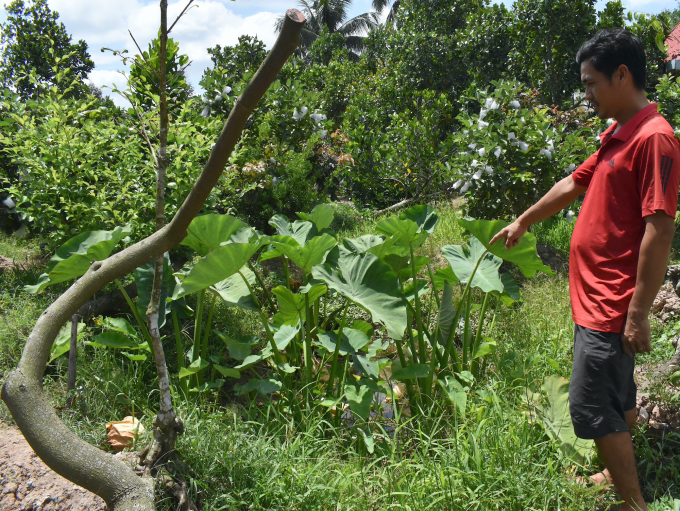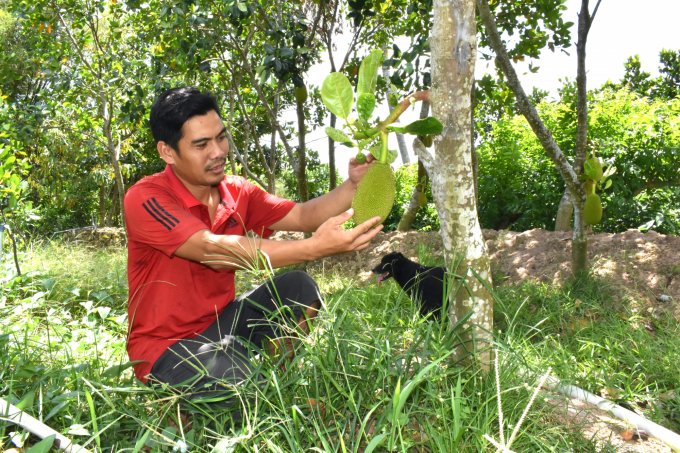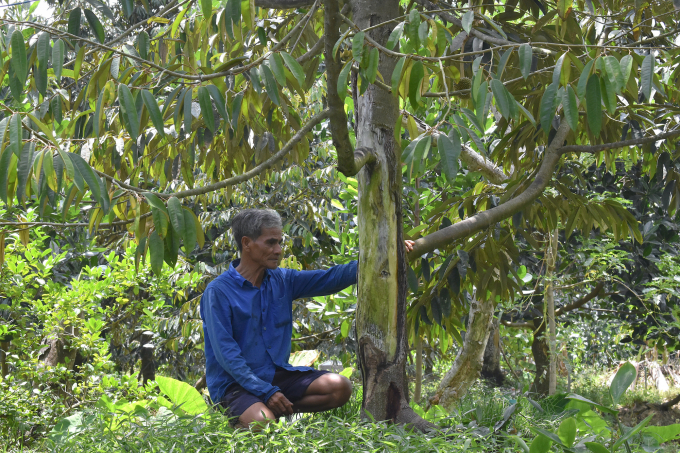June 21, 2025 | 03:35 GMT +7
June 21, 2025 | 03:35 GMT +7
Hotline: 0913.378.918
June 21, 2025 | 03:35 GMT +7
Hotline: 0913.378.918

Mr. Nguyen Thanh Ut next to the ditch location he and his wife carried one can of water after another back to reserve for their plants two years ago. Photo: Minh Dam.
Since the early days of March this year, the Mekong Delta has had a few unseasonal drops of rain to soothe the hot, sultry sun of the late spring days. Although the situation of drought and saltwater intrusion is not forecasted to be as severe as in the 2019-2020 dry season, the possibility of saline intrusion is still higher than the average of many years even when compared to the dry season of 2020-2021.
Learning from previous drought and saline periods, in the last two years the authorities and people of provinces and cities in the Mekong Delta have always been in a "defense" stance against unexpected saltwater intrusion. Many ready-made plans to cope with drought - salinity are prepared in detailed scenarios.
When we went to the land of fruit in Tan Phong islet commune, Cai Lay district, Tien Giang province, all we saw were crops heavily affected by the previous drought and salinity period. They became so weak and shriveled that it might take a long time to recover.
After a few conversations with the local people, we realized that although many plans had been prepared for unexpected saltwater attacks, many people were still afraid of its return.
Ms. Ho Thi Xuan Dao, Vice Chairwoman of Tan Phong Commune People's Committee told us that this place was seriously affected by the previous severe drought and saltwater season. Nearly 2‰ of saltwater surrounded the island for three months continuously. The problem was that the total area of fruit trees in Tan Phong was nearly 1,300 ha, but saltwater sensitive fruit trees (salinity threshold less than 0.5‰) account for a large proportion, for example durian was over 678 ha, and rambutan was nearly 206 ha.

After that drought - salt period, Mr. Ut changed the once dead durian orchard into a place for growing jackfruit. Photo: Minh Dam.
Mr. Nguyen Thanh Ut (36 years old) in Tan Thien hamlet is one of the households with 5,000 m2 of 2.5-year-old durians that died in the drought-salt season that year. His household was provided with nearly 40 m3 of freshwater by Tan Phong Commune People's Committee. He and his wife used a motorbike to carry 20l cans of water one after another regardless of the time. They just wanted to save any tree possible as the garden was too exhausted at that time due to many days without a drop of water. Despite their best efforts, only two trees survived.
Mr. Nguyen Van Coi in Tan Thien hamlet also had 0.5 ha of land growing rambutan and durian that suffered the same fate as the orchard of Mr. ut. After that drought - salt period, Mr. Coi's orchard only had a dozen durian trees left. All 3,000 m2 rambutans were dry to death, only rotten wood stumps remained.

“The remaining durian roots were unable to grow well and became vulnerable to many diseases.” - Mr. Coi. Photo: Minh Dam.
The families of Mr. Ut and Mr. Coi have renovated the garden at the present time. Both of them plant super-early jackfruit trees to make up for the recent loss. Mr. Ut's orchard has harvested 2,000 m2 of jackfruit and sells them for nearly VND 50 million. Mr. Coi has not yet sold any.
However, in terms of economic efficiency, durian is many times better than jackfruit. “The income from 5,000 m2 of jackfruit is only equal to 1,000 m2 of durian,” said Mr. Ut.
The jackfruit tree is not efficient, easy to disease, quickly dies, and is not sustainable, so Mr. Ut intends to replant durian trees. However, he keeps hesitating for fear of saltwater coming again and causing him to lose everything again like last time.
As for Mr. Coi, he does not know what to plant apart from jackfruit. But jackfruit’s life expectancy is not high as the price constantly fluctuates. “The salty durian orchard has not fully recovered, so I do not dare try for a replant right away. I still leave many slots in the orchard vacated because I don’t know which plants can bring the most profit.”
Translated by Samuel Pham
![Turning wind and rain into action: [9] Digitizing hydrometeorological data in response to climate change](https://t.ex-cdn.com/nongnghiepmoitruong.vn/608w/files/news/2025/06/17/z6704423696987_15fd32ffc26d590d204d520c9dac6786-nongnghiep-165943.jpg)
(VAN) Farmers have begun accessing hydrometeorological applications to adjust their cropping schedules, aiming to ensure productivity and adapt to climate change.
![Turning wind and rain into action: [8] Real-time salinity detection and early warning technology](https://t.ex-cdn.com/nongnghiepmoitruong.vn/608w/files/news/2025/06/17/z6704423696987_15fd32ffc26d590d204d520c9dac6786-nongnghiep-151127.jpg)
(VAN) Thanks to the integration of modern hydrological-hydraulic models, remote sensing technologies, and artificial intelligence, the accuracy of hydrological forecasting has significantly improved.
![Turning wind and rain into action: [7] Early disaster warnings help marine farmers minimize losses](https://t.ex-cdn.com/nongnghiepmoitruong.vn/608w/files/news/2025/06/17/z6704423696987_15fd32ffc26d590d204d520c9dac6786-nongnghiep-142942.jpg)
(VAN) In recent years, thanks to early disaster warnings and forecasting, marine farmers in Khanh Hoa province have been able to reduce risks and losses, thereby improving production efficiency.
![Turning wind and rain into action: [6] ‘Four on-the-spot’ disaster management software](https://t.ex-cdn.com/nongnghiepmoitruong.vn/608w/files/news/2025/06/17/e5a48259d6a262fc3bb3-nongnghiep-183800.jpg)
(VAN) By simply activating the scenario on the disaster management software, the relevant authorities immediately know how many households need to be evacuated, where to evacuate them to, and by what means of transportation…
![Turning wind and rain into action: [5] Hue applies modern technology in disaster forecasting](https://t.ex-cdn.com/nongnghiepmoitruong.vn/608w/files/news/2025/06/17/z6704423696987_15fd32ffc26d590d204d520c9dac6786-nongnghiep-093938.jpg)
(VAN) In Hue city, modern technology has recently been applied in meteorological and hydrological forecasting and warning, helping to reduce the damage caused by natural disasters.

(VAN) A cutting-edge farming technique being implemented on an experimental ranch in Arizona's Sonoran Desert has already saved a billion gallons of water over five years, according to Civil Eats.

(VAN) Poultry and pig production and the environment can be boosted through enhanced water technology, according to new research.